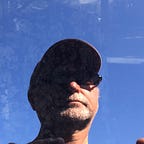FICTION
A Jasper Jones and Lena Adventure
Exploring the possibilities in physics
The alarm doesn’t ring anymore. There’s no point. It’s 7:00 AM, August 10, 2055, and I’m still unemployed, another victim of the systematic collapse that has left the world in ruins. I spend hours poring over old personal physics and mathematics journals I’ve made notes in for 30 years; trying to make sense of our reality and find some way to change it.
Without a job to anchor my days, I’ve taken to researching what went wrong — how we ended up in this dystopian nightmare. But there is a flicker of hope. I am not alone in my quest. Two years ago, I met Lena Kovac and Rajiv Mehta in the ruins of an old university library. I was scavenging for books, desperate for knowledge that had been lost in the chaos. They were there for the same reason, though at first, we eyed each other warily. Trust was a rare commodity. Their aged faces looked haggard, but determined.
“Looking for something specific?” Lena had asked, her voice soft but with a determined edge.
“Anything that can explain what went wrong,” I replied, holding up a dusty physics textbook.
We ended up talking for hours, sharing our theories and frustrations. Lena was a physicist, one of the last few who still believed in the power of science to save us. Rajiv was an engineer with a deep understanding of quantum mechanics. Together, they had an idea, a wild one, about using theoretical physics to fix the mess we were in. They called it time travel.
“We need to find a way to manipulate time,” Lena had said, her eyes alight with possibility. “If we can go back, prevent key events, we might have a chance.”
I was skeptical, but the desperation of our reality made their idea seem worth exploring. Together, we began working on their equation, spending countless nights in the dim light of my apartment, poring over calculations and old theories.
Our breakthrough came when we combined elements of Einstein’s field equations with principles of quantum mechanics. We started with the Einstein field equations, which describe the fundamental interaction of gravitation as a result of spacetime being curved by mass and energy. However, we needed something more to account for the complexities of time travel.
Rajiv suggested incorporating aspects of string theory, particularly the idea of higher dimensions. We realized that our universe might be just one of many dimensions and that manipulating these dimensions could allow us to alter the fabric of time itself.
Lena proposed the inclusion of quantum mechanics, especially the concept of quantum entanglement, which suggests that particles can be connected in such a way that the state of one instantly influences the state of another, regardless of distance. This led us to the idea that time might also be entangled, and manipulating one point in time could influence another.
After months of intense collaboration, we derived the following equation:
It had the conditions necessary for time travel — a delicate balance of energy, space, and time that we hypothesized could create a temporal bridge. We theorized that by adjusting the parameters we could manipulate the temporal dimension.
Months turned into years, and our equation evolved. We refined our understanding and continued to test our theories, often failing but always learning. Lena’s brilliance, Rajiv’s ingenuity, and my stubbornness kept us going. Our bond grew, forged in the determination of our shared mission.
Last night, we had our first success. A small, controlled experiment showed a measurable effect — an object, a mere particle, had shifted in time. It was a minuscule step, but it proved our equation could work.
Today, Lena, Rajiv, and I sat in our makeshift lab, the early morning light filtering through the cracked window. The city outside was waking up to another day of survival, but we were on the brink of something monumental.
“We have to test it on a larger scale,” Lena said, her voice filled with both excitement and trepidation. “If we can send a message back, just a small one, to warn about the critical points…”
I nodded. “We need to pinpoint the events that led us here. The environmental tipping points, the political decisions, the technological advancements that were misused.”
Our plan was ambitious: to send a message back to 2020, when the world was on the cusp of irreversible changes. If we could reach that year, we could provide the knowledge and warnings necessary to alter the course of history.
As we prepared the device, a nervous energy filled the room. This was it — the culmination of our work, our hopes, and our fears.
Lena set the parameters, her fingers dancing over the controls. Rajiv checked the energy levels, making sure everything was calibrated perfectly. I watched them, feeling a surge of gratitude and admiration. We were partners in this, against all odds.
“Ready?” Lena asked, looking at Rajiv and me.
“Ready,” we replied in unison, taking a deep breath.
With a final adjustment, Lena activated the device. A hum filled the air, growing in intensity. The room seemed to shimmer, the edges of reality blurring. We held our breath, waiting for the moment that could change everything.
A small portal opened, a ripple in the fabric of time. We sent our message, a concise warning with critical information. It vanished into the temporal bridge, heading back to 2020.
The device powered down, the hum fading. We sat in silence, the enormity of what we’d done sinking in.
“Now we wait,” Lena said, her voice barely a whisper.
Thank you for reading. You may also enjoy these.
